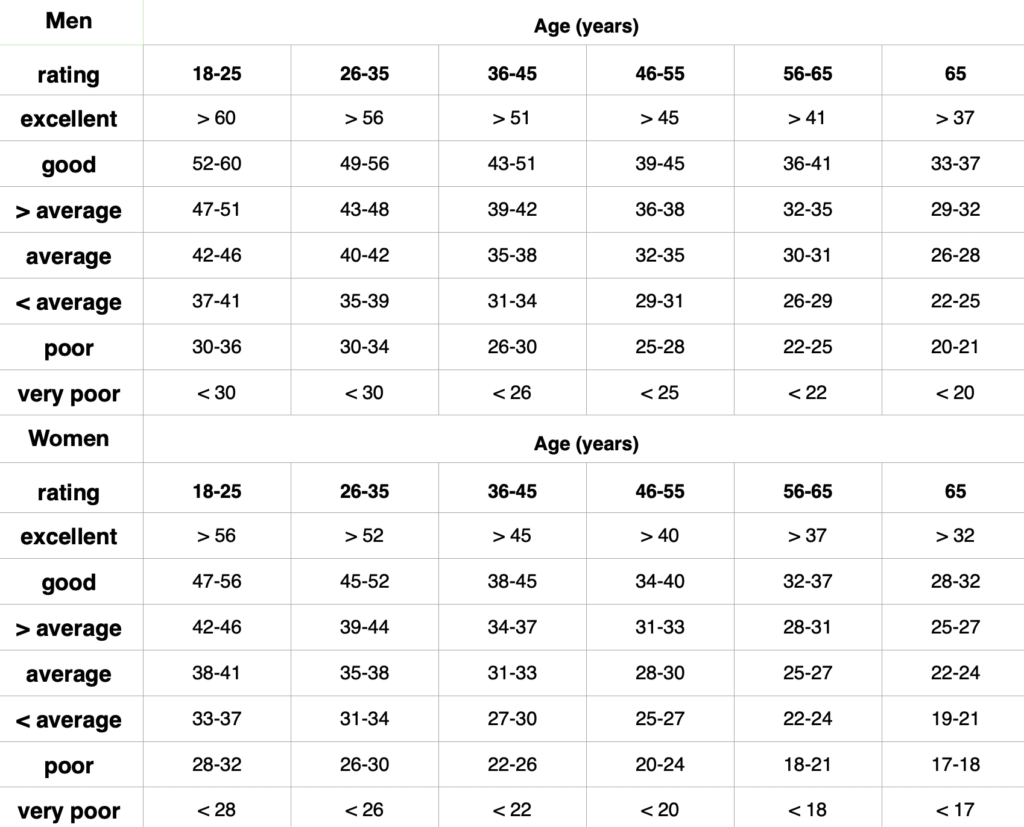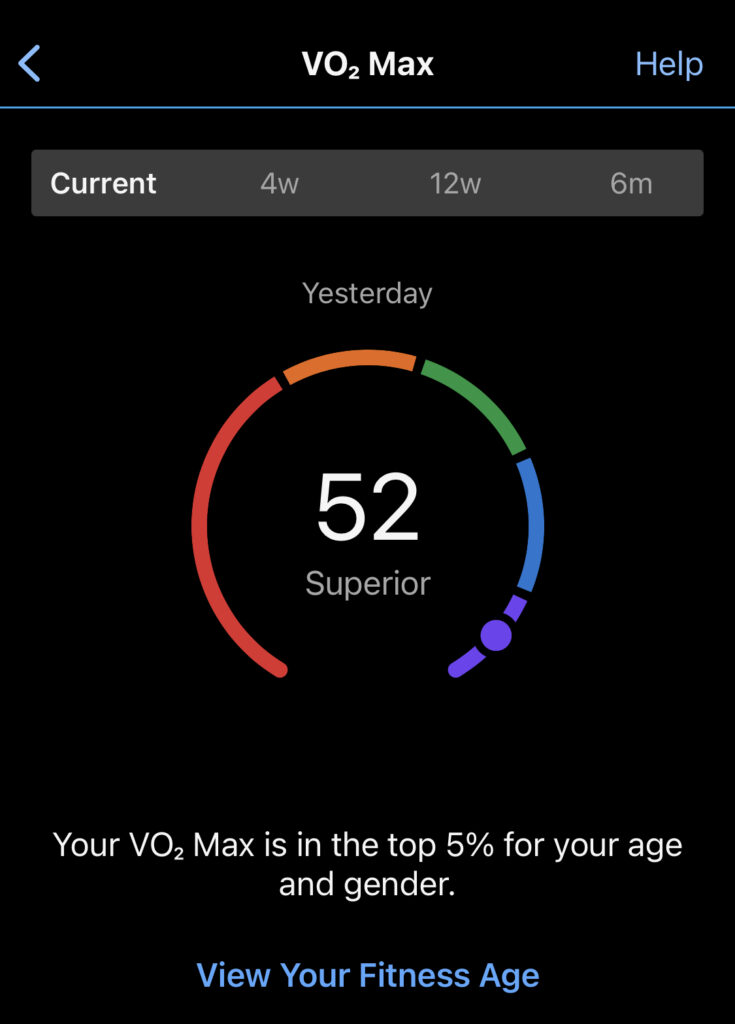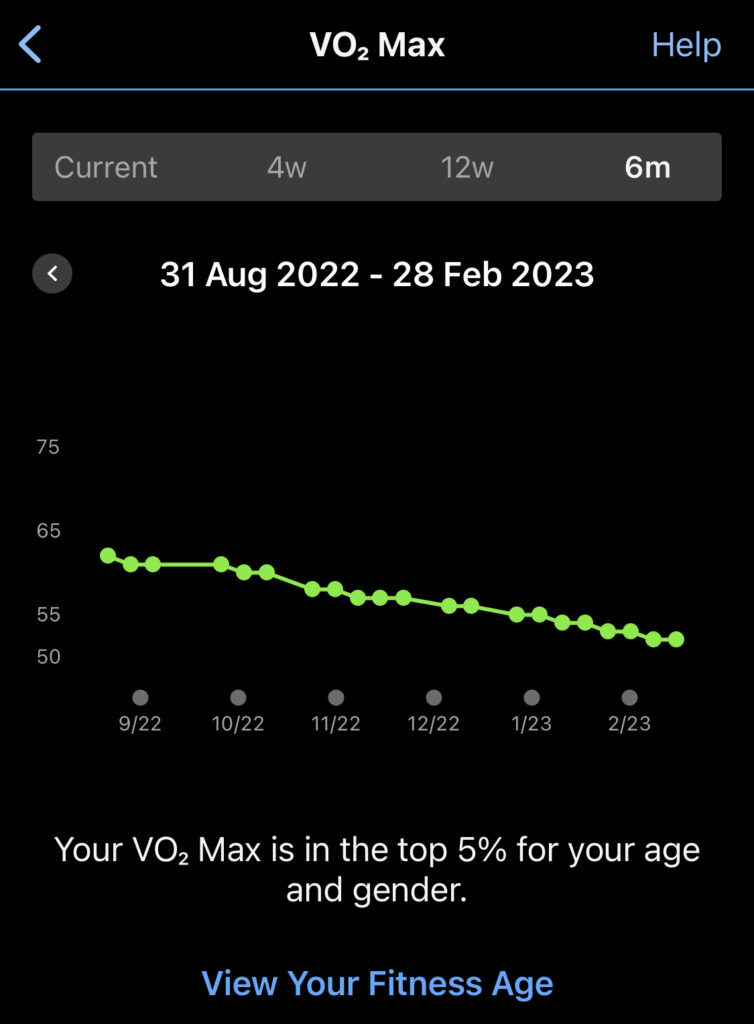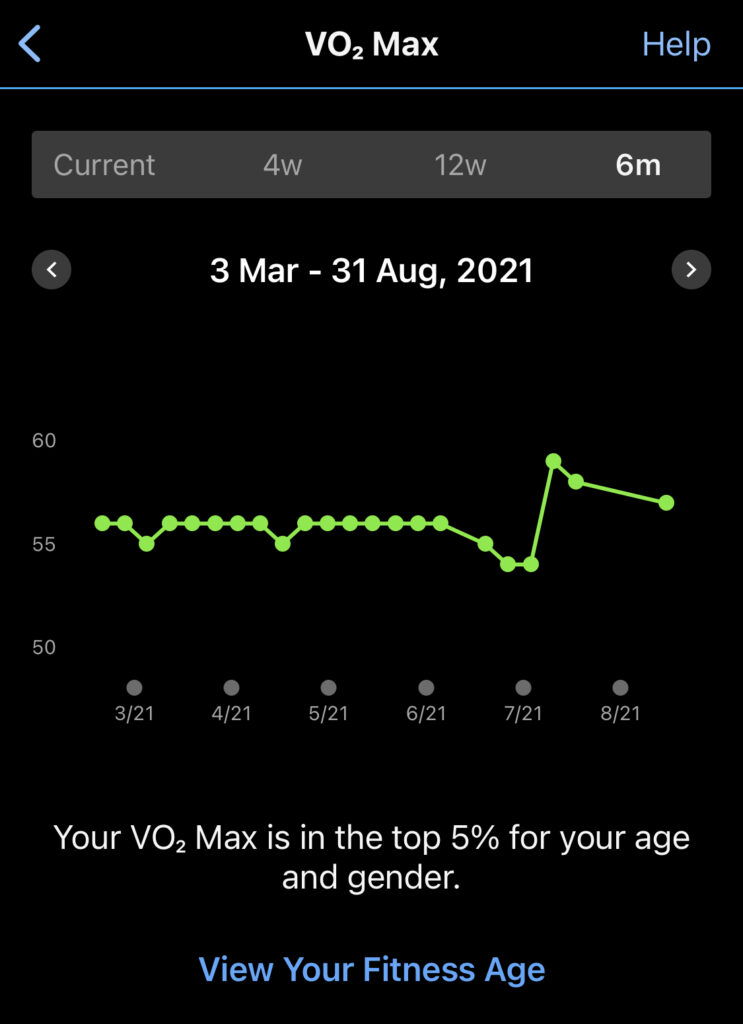Many fitness trackers now include estimates of V02 Max. But what is it? What does it mean? Who Cares About V02 Max?
What is V02 Max?
VO2 max is how much oxygen your body can absorb and use during exercise. Per wikipedia.com – The name is derived from three abbreviations: “V̇” for volume, “O2” for oxygen and “max” for maximum.
It is widely used as an indicator of cardiorespiratory fitness. In simple terms the fitter (better) you are at running for example the higher measurement.
Example Measurements By Age
There are many tables available on the internet with slightly differing values for ideal measurements per age and sex. The tables below are an example.

I use these a guide only as we are not all are created equal but like to see how I measure up.
How Do Watches Calculate It?
I am a Garmin watch owner (Fenix 7). It is really a great bit of kit. Per Garmin’s website – they calculate a number of physical metrics including VO2 Max using Firstbeat Analytics which is a company they acquired some years ago that specialised in this field.
Their watches calculate a VO2 Max following the completion of a series of outdoor runs or bike rides. This points to heart rate, and GPS speed, distance and elevation as the main factors in the calculation.
The number is presented as a metric on their app and advises where you fit in their view similar to the table above. All is well and good so far or is it?

Mine currently looks like this. I am a 53-year-old male. Per the table above I’m “Excellent”. Who Cares About V02 Max – I Do!

In September 2022 my VO2 Max was 62. I have dropped 10 points. This is a depreciation of some 16 per cent in my VO2 Max in around six months.
I don’t believe that to be the case and think that as good as this watch is, the calculation method has a number of flaws.
Flaw 1
I have been running a little differently over the last few months. I am purposely running at a much slower pace to try out the benefits of lower HR zones. My watch can see the runs and perform the calculations. But does it assume you are running at the limit of your capability? Probably to an extent. This means there are lots of key data points being impacted. Lower HR, lower speed, extended run duration etc.
Flaw 2
You can absolutely confuse the device into providing an incorrect calculation. If you see my VO2 Max from the summer of 2021. You will see I suddenly got much fitter. I don’t recall training harder although I was putting in the miles.

However, what I was doing during the period was having a nice holiday in Crete. If you check the hotel website you will see there is a small water park with slides. My kids and myself, mostly myself enjoyed this very much.
Maybe the repeat stair climbs carrying inflatables were the reason my V02 Max increased so greatly in a short space of time.
I think it is much more likely the fact I recorded a run activity or two on my watch up numerous flights of stairs and then down the slides at high speed as the reason.
The watch sees my heart rate rising, elevation increasing albeit at a leisurely pace and then a sudden rapid descent with little or no effort on my part. This is then repeated a number of times.
Flaw 3
I suspect the watch is a little generous in its calculation. Having conducted a scientific exchange of views with other runners. We have all undertaken some specific runs and calculated the VO2 Max independently (see below). The general consensus is Garmin devices for example give you a 2-4 higher score in VO2 Max.
If you combine this with the already heightened VO2 Max from Flaw 2 with additional subsequent training benefits added on you see its easy to overcook this.
So while that’s not all bad it’s also good to bear in mind.
How Can You Calculate It?
The generally accepted golden source to calculate the VO2 Max is based on the Cooper test. This is a U.S. military physical test devised in the 1960’s. I must confess I was completely ignorant of this test until recently when I heard Dr Andy Galpin discuss this on a podcast with Dr Andrew Huberman. The Cooper test was really just a small snippet of mind-boggling detail laid out by Dr Galpin. I thoroughly recommend taking the time to listen to all the series as you will likely learn many new and important aspects to health and exercise.
The test is quite simple. You start the clock and run for 12 minutes. At the end of that time you record how far you have run. Then you perform a simple calculation and get the VO2 Max number.
The calculation is as follows:-
In Miles: VO2max = (35.97 x miles) – 11.29.
In Kilometers: VO2max = (22.351 x kilometers) – 11.288.
Lets say you run 1402 metres. Thats (22.351*1.402)-11.288 = 20.048
There are lots of nice calculators that do this for you.
What Does This All Mean?
The Cooper test ideally should be run on a flat track in perfect weather in order to get the most precise reading. This is not readily available to most of us at all times.
My approach has been to run outside for 12 minutes along the same route. It is relatively quiet traffic wise although a bit undulating both up and down. My theory is if I run the same course to test at least I have a comparison to work from.
My most recent attempt came out just over 49 for VO2 Max. So it’s pretty close to Garmin but I definitely had some left in the tank as I just did the test at the start of a regular run.
What this means for me is I have a really easy way to validate the watch or my fitness to some extent.
Why Does The Cooper test Interest Me?
Running for 12 minutes is a tough test. Let’s say you crack out the first five minutes and are starting to flow. You will likely start to check the time left from about seven minutes in. You will probably be gasping for breath and hanging on as you approach ten minutes.
The last two minutes will fly by as you approach the end trying to push the distance. It’s a bit like the way the 400m is a sprint-type race.
12 minutes is just a killer time for distance and you can blow up if you go out too hard too early.
My plan now is to repeat the 12 minute run at regular intervals and check it versus the number Garmin tells me. I hope to see a gradual uptick in number over the coming months and realise the longer slow runs might have to take a back seat for a while.
I will report progress at some stage so please check back here in the future.
Before You Go?
I write about lots of different things on this blog. Please have a read of some other articles you may find interesting.



